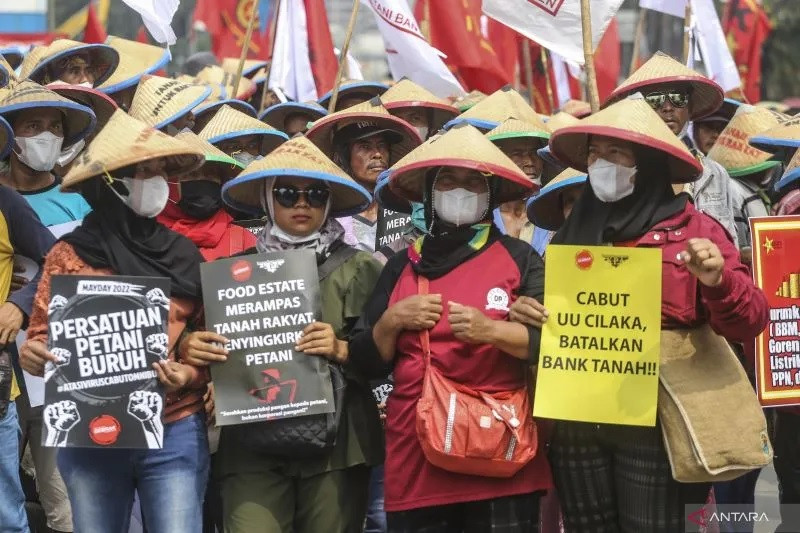Popular Reads
Top Results
Can't find what you're looking for?
View all search resultsPopular Reads
Top Results
Can't find what you're looking for?
View all search resultsOpportunity to reconsider labor rules in Job Creation Law
The obvious solution is to remove the amendments to the 2003 Labor Law from the Job Creation Law and then enact a fresh piece of original legislation.
Change text size
Gift Premium Articles
to Anyone
T
he House of Representatives (DPR) now appears set to reenact its controversial omnibus Law on Job Creation, or more popularly known as the Job Creation Law, having just paved the way by explicitly enabling omnibus law formats.
This move responds to the Constitutional Court’s ruling of Nov. 25, 2021, which found the job creation law to be conditionally unconstitutional on two grounds: Its use of an omnibus law format and lack of prior public consultation. The House was given two years to rectify these problems.
There is now a need to hold public consultations to deal with the Constitutional Court’s second objection, and therefore the House still has the chance to reconsider the content and form of the law.
The labor cluster of amendments within the law has been particularly controversial and vehemently opposed by the labor movement. Trade unions have highlighted the removal of time restrictions on fixed-term contracts, reductions to severance pay calculations, and the removal of dismissal procedures, among other issues.
My in-depth legal analysis of the labor cluster of amendments indicates that there is another set of largely unrecognized, problems.
The first issue is that having the large number of labor law amendments buried within the voluminous Job Creation Law impedes access to legal information. It personally took me many hours of flipping between the original 2003 Labor Law, the Job Creation Law amendments, and the related implementing regulations to understand exactly how the law had changed.
While this is a generally occurring problem because Indonesia does not publish official amalgamated versions of original laws with their amendments, it is particularly problematic in the area of labor law, which affects the everyday lives of so many people.
Both employers and workers need easy access to clearly stated rules. The obvious solution is to remove the amendments to the 2003 Labor Law from the Job Creation Law and then enact a fresh piece of original legislation.
Second, when the Job Creation Law’s labor cluster and its implementing regulations are considered together, it appears that they were drafted as an integrated package. Certain issues which disappeared in the law, such as severance pay calculations, then strategically reappeared in the implementing regulations promulgated three months later.
This blending of legislative and executive law-making functions is a worrying challenge to principles of the rule of law and separation of powers. This problem can be linked to various commentators’ concerns about the recent democratic decline in Indonesia.
Third, and relatedly, the labor cluster and its implementing regulations also represent an abdication of legislative power to the executive. Numerous labor law rules, such as severance pay calculations, have been shifted down the legal hierarchy. While there is certainly some logic to placing the detailed calculations in the regulations, it has arguably made these issues more susceptible to future change by executive decision-makers.
In doing so, these rules have also been moved out of the judicial review jurisdiction of the Constitutional Court into that of the Supreme Court, which has traditionally been far more reluctant to uphold judicial review challenges. Arguably, the House members need to guard their legislative powers better if the Job Creation Law (or a new separate labor law) is reenacted.
Finally, the Job Creation Law’s labor cluster also includes various legislative responses to Constitutional Court judicial review decisions of the 2003 Labor Law. It is healthy for the House to either affirm or override the Court decisions in this way, but there are some anomalies found in the details.
The new rules relating to the dismissal of workers for gross misconduct have been deliberately shifted out of the realm of criminal law into civil law as a breach of contract. To do this, these rules have been pushed down the legal hierarchy into one of the implementing regulations and its elucidation, thereby “hiding” them from the Constitutional Court’s review jurisdiction.
There was also one Constitutional Court case overlooked. Decision No. 115/PUU-VII/2009, which interpreted the law to allow up to three unions to be proportionally represented in collective bargaining, has been ignored in the job creation law amendments, leaving the Court’s ruling in place.
Indonesian media have widely reported that many legislators did not even read the job creation bill before voting. Given the sheer complexity of the labor cluster of amendments and the very short period within which the House debated the labor cluster in 2020, this does indeed appear likely on the evidence of the legal details.
Whether or not the House responds to the labor movement’s objections to the Job Creation Law is a political decision. Regardless, there is now a real opportunity for legislators to carefully examine the legal details of the labor cluster and ameliorate its defects.
…
The writer is a senior lecturer at the Department of Business Law and Taxation, Monash University, Melbourne.










